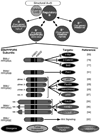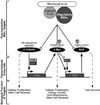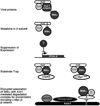A tumor suppressor role for PP2A-B56alpha through negative regulation of c-Myc and other key oncoproteins
- PMID: 18246411
- PMCID: PMC3045695
- DOI: 10.1007/s10555-008-9128-9
A tumor suppressor role for PP2A-B56alpha through negative regulation of c-Myc and other key oncoproteins
Abstract
Loss or inhibition of the serine/threonine protein phosphatase 2A (PP2A) has revealed a critical tumor suppressor function for PP2A. However, PP2A has also been shown to have important roles in cell cycle progression and survival. Therefore, PP2A is not a typical tumor suppressor. This is most likely due to the fact that PP2A represents a large number of different holoenzymes. Further understanding of PP2A function(s), and especially its tumor suppressor activity, will depend largely on our ability to determine specific targets for these different PP2A holoenzymes and to gain an understanding of how these targets confer tumor suppressor activity or contribute to cell cycle progression and cell survival. Recent work has identified c-Myc as a target of the PP2A holoenzyme, PP2A-B56alpha. This holoenzyme also negatively regulates beta-catenin expression and modulates the anti-apoptotic activity of Bcl2, thus characterizing PP2A-B56alpha as a tumor suppressor PP2A holoenzyme. This review will focus on the role of PP2A-B56alpha in regulating c-Myc and will place this tumor suppressor activity of PP2A within the context of its other tumor suppressor functions. Finally, the mechanism(s) through which PP2A-B56alpha tumor suppressor activity may be lost in cancer will be discussed.
Figures




References
-
- Sansal I, Sellers WR. The biology and clinical relevance of the PTEN tumor suppressor pathway. Journal of Clinical Oncology. 2004;22:2954–2963. - PubMed
-
- Parsons R. Phosphatases and tumorigenesis. Current Opinion in Oncology. 1998;10:88–91. - PubMed
-
- Van Hoof C, Goris J. PP2A fulfills its promises as tumor suppressor: Which subunits are important. Cancer Cell. 2004;5:105–106. - PubMed
-
- Schonthal AH. Role of serine/threonine protein phosphatase 2A in cancer. Cancer Letters. 2001;170:1–13. - PubMed
-
- Galaktionov K, Lee AK, Eckstein J, Draetta G, Meckler J, Loda M, et al. CDC25 phosphatases as potential human oncogenes. Science. 1995;269:1575–1577. - PubMed
Publication types
MeSH terms
Substances
Grants and funding
LinkOut - more resources
Full Text Sources
Other Literature Sources

